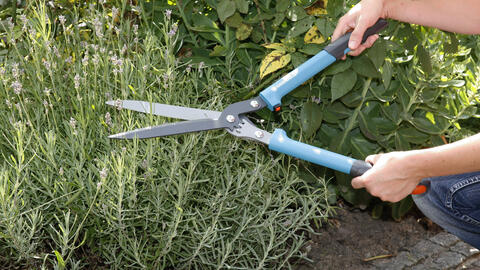Pruning Lavender correctly
If you want your Lavender to grow compactly and bloom profusely even after several years, it has to be pruned regularly. This is how you do it.

Pruning Lavender correctly
Lavender originates from the western Mediterranean and is grown agriculturally there for the extraction of fragrances for perfume production - who does not know the endless Lavender fields, the classic postcard motifs from he Provence? In home gardens English Lavender (Lavandula angustifolia) is also quite popular as a decorative plant. Lavender is most often seen with rose bushes and it has adorned baroque gardens of central Europe since ancient times.
- From the end of February, prune the previous year's shoots back to short stems with a garden or hedge trimmer
- Shorten the withered shoots by a third in the summer after flowering
- Do not prune Lavender back into the perennial unleaved wood - it then usually does not sprout again.
- The chances of success of a strong regeneration pruning are highest in June/July
Lavender grows to a height of 11.8 inches to 23.6 inches. It is often thought of as a shrub, but from a botanical point of view it is actually a subshrub. The one-year-old shoots initially remain weedy and become woody from the base as the years pass. The undemanding, sun-loving Lavender prefers dry, poor soil and should therefore not be fertilized. A native of southern Europe, the Lavender is fairly sensitive to frost — especially if it grows in very moist, nutrient-rich soil. The ideal location is a south-facing, covered place in front of a house wall. The best time to harvest Lavender, is right before blossoming.

Lavender needs to be pruned strongly every year to keep it compact. If the plants are allowed to grow unpruned for several years, they will fall apart and fall bare from the bottom. The woody branches do not form new shoots by themselves and only sprout reluctantly even after pruning.
The "one-third – two-thirds method" works well for trimming Lavender: After blossoming, use a hedge trimmer to prune all shoots by about a third to remove all withered inflorescences and to largely preserve the leafy branch sections. Aggressive pruning to two thirds should be done in spring, so that the plants remain compact and branch out beautifully. Best time to prune the plant is as soon as no permanent frost conditions are expected.
Important: When pruning in spring, leave a short section of last year's shoots with a few leaves so that the Lavender bushes can grow back again.

Old, fallen Lavender bushes with sparse, woody main shoots can in most cases no longer be saved by a strong rejuvenating cut. But as it is so often the case in the life of a gardener, in case of doubt it is important to give it a try. The success seems to depend heavily on when the Lavender is pruned because some hobby gardeners report that after a radical pruning in June / July their old lavender bushes emerged again in the same year and bloomed beautifully again the next year.




